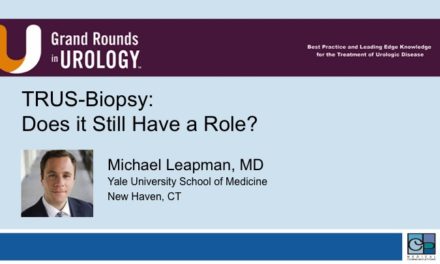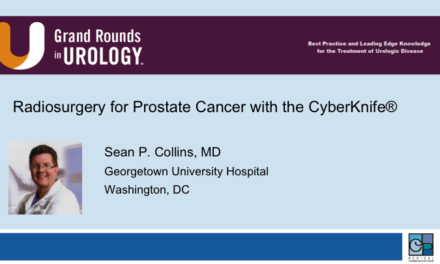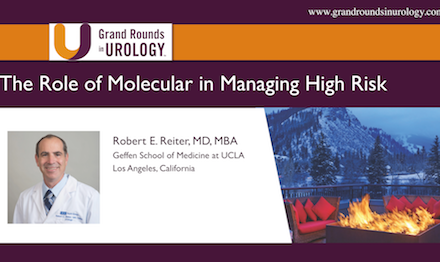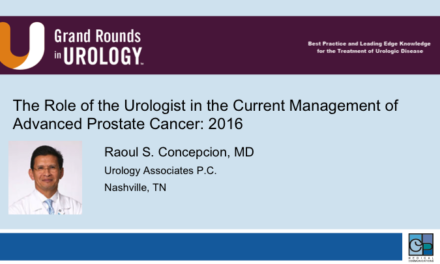Dr. Finkelstein presented at the 26th International Prostate Cancer Update on Friday, January 22, 2016 on “Current and Future Opportunities Combining Radiation and Immunotherapy.”
Keywords: prostate cancer, radiation, immunotherapy, imaging
How to cite: Finkelstein, Steven. “Current and Future Opportunities Combining Radiation and Immunotherapy” Grand Rounds in Urology. January 22, 2016. Jan 2025. https://dev.grandroundsinurology.com/prostate-cancer-steven-finkelstein-current-and-future-opportunities-combining-radiation-and-immunotherapy/.
Transcript
Current and Future Opportunities Combining Radiation and Immunotherapy
I’m going to talk about current and future opportunities in combining radiation therapy and immunotherapy. Now interestingly when I started this about almost 15 to 20 years ago, people said that immunotherapy radiation would never go together. That radiation is an immunosuppressive. That this is the stupidest idea that they ever heard. So I’m glad that the room like this thinks that what I’m doing is not too crazy. Indeed our mission is to try to use novel therapies such as immunotherapies to elicit radiation-induced personalized systemic therapy. So it’s interesting Dave has had a couple folk speak about radiation at this meeting all of which were surgeons at some point or are currently. And so my background is in and it has been pretty interesting and I’m going to walk you through this journey of a guy who went to medical school at 16; decide he wanted to be a surgeon; did general surgery; did surgical oncology and immunotherapy; and what this slide shows is that I’ve aged visibly over the years. And so look if you could look all the way to the left there that’s what I look like then.
And so this is in 2012 with, in Steve Rosenberg’s lab and you can see all of us of age visibly with gray or more hair. So and our group is very successful at the turn-of-the-century as you can see from his publication chain. In really going to to look for from bench to bedside in how animal models could guide principles of immunotherapy. This is before it be, this is before PD1. And we really had interleukin 2 and some other things. That didn’t work as great as we would potentially want.
So I was a surgeon for 10 years working at the National Cancer Institute’s as a government servant and what most of my focus was on is this. We were able to build a platform that resembles some of things that you’ve seen that Neil showed. Of adoptive cell transfer the idea of taking T cells that could be reactive against cancer and coupling them with potential systemic therapies in this way. I’ll too an end and also in this case with a vaccine and it didn’t really work as well as we’d like until. All until we brought in the use of radiation therapy. So you know when you sit in a meeting like this for three days. You stare at graphs and sometimes you go crazy. But that bottom slide for our mouse survivors. These are mice who were given horrible melanomas of which not only had cancer aggression is seen in the graph. But they’d, their cancer went away completely and they started to go after this melanomas.
So they went after their coat and so it had a robust immunologic response against not just the cancer but themselves. We ultimately took this from animals to the clinic. We saw same thing in humans and this in PNAS. And so I got really excited about this idea that radiation could be a trigger to generate robust immune responses against cancer. But I was a surgeon. I didn’t know a thing about radiation therapy. So I had go back to school which is not always fun after 10 years. And what I learned from the textbook and it was one page in the textbook. And it said that radiation should never never never be done with immunotherapy. Because immunotherapies immuno suppressive indeed we use it for bone marrow transplant preconditioning right. But that’s like radiating a whole person, when we do radiation for prostate cancer we’re radiating really small focal areas. And we were classically taught that radiation causes just double some double-stranded DNA breaks and that’s the way it works. And that’s probably was not the whole story there is a direct interaction between radiation tumor cells and the immune response.
Indeed radiation when radiate tumors in the case of prostate cancer for nine weeks we can release what we call danger signals such as damage associated molecular patterns or damps. Which induce expression of things like cytokines chemo kinds and inflammatory mediators, things that you would expect. This is probably what happens when we radiate things. And this is probably a simplifies version of what happens when we radiate targets i.e. prostate cancer. We get up regulation of MHC class I molecules, adhesion molecules, co-stimulatory molecules, heat shock proteins, inflammatory mediators, inflammatory cytokines and death receptors. Indeed the reason I went back to school for ten years, after 10 years was the fact that when we radiate things it’s probably more immunogenic than when we cut it out and put in a bucket.
That’s great so I cured a couple of animals and Steve will say Steve Rosenberg will say I probably cured the most animals of the NCI history. But doesn’t really help people a lot so the ideas to go from bench to bedside and back again. When my fellow reviewed, when my fellow reviewed the trials that had been done previously with respect to immunotherapy and radiation. This is in 2014 at the end of 2014. I’m happy to report it actually made its way to a table like this and you can see in the top of the studies there’s actually some of our seminal work. And others have really start to get interested. This unfortunately doesn’t project that’s a study in prostate cancer. That’s a seminal study in in sarcoma using radiation therapy with immunotherapy. What we learned is beforehand, beforehand were not really generating robust immune responses. Make sense right a person has a big cancer growing in them there immune system was never built to go after yourself. Only when you trick the immune system that something wrong is there. Do you actually start going after self-antigens.
So the key is to go and go back and forth between the bed side and the bench. So we need to frame the appropriate questions in humans. So radiation research is really lag behind medical oncology research and even surgical research. Why because nobody’s willing to spend the money to buy something that you can radiate animals in an intelligent way that looks like we do in humans. So we’re a private practice group right. Well we have with a collaboration with TJ and TD2 and the cancer the pharmaceutical development company TD2 to spin off of of a TGem. We’re able to build a center that we could enable rapid testing of anticancer drugs as they combine with radiation. So let me show you what that looks like. And it uses something called a SARRP unit how many of you have seen a SARRP unit before? Well you’re going to see it today.
So ARIEL is the name of our laboratory the animal radiation imaging immunotherapy experimental lab and this is our head physicist and head technician that thing behind it is a SARRP unit. Essentially what it is, it’s a miniature radiation therapy linear accelerator unit of which we can radiate animals like we do humans. We can control it like we do a radiation unit in people. We put them on a little table, which we call the same thing like we do in race called a couch. And we clinically set them up just like we do in humans. We can video monitor them and image them just like we do in humans. And then we can use focused radiation and I GRT just like we do in humans. And so what we can do here I know this is always fun after lunch to see pictures of animals. We can do relevant experiments that in preclinical work test. Hopefully before we get into Phase 2 Phase 3 trials to try to make some intelligent decisions about building expensive experimental trials. So ARIEL’s real key mission is to combine radiation with a variety of drugs. Some immuno logic some other novel mechanisms and we hope that this will help move the bar forward. But my main argument to our radiation oncology colleagues and if I asked the audience I would say this probably no one here from radiation oncology right? But when I got on the podium at ASCO and gave the plenary session, I said it’s great people are doing studies in animals and studies in dishes but does number of studies in humans is pretty limited. Neil showed you a couple of let me show you the one that we think may be more most robust.
Indeed there are incredible clinical opportunities when you look at the current clinical trials. Now it’s made its way to two pages of which this will, is the largest radiation immunotherapy trial pretty much ever built and I’m happy to say I’m the PI while Neil is a co-investigator. And I don’t need to teach this room the background that prostate cancer is bad. And we know in the setting of recurrent disease we start with in-depth risk preparation is the standard of care. And obviously Neil talked about the spectrum of what comes next. Our research hypothesis is that radiation combined with Provenge may improve outcomes as seen on imaging as well as immuno logic monitoring than just doing immunotherapy by itself.
I don’t need to educate this audience of what Provenge is or sipuleucel-T, it is an autologous cellular immunotherapy Pratt platform designed to stimulate autoimmune, so antigen response against self for prostate cancer. And it’s had its ups and downs as we talked about in 2010 – 2011 and it’s really built on three seminal trials seen here, here and here which showed improvement in overall survival. And at the time it was the first agent, it was the first agent that actually showed an overall survival. And it got a lot of issues people talking about it at that time but now that there’s not one, not two, not three, not four, not five but six new things that have all showed overall survival. People are pretty much given it the fact that, yes it probably did cause an improvement in overall survival.
The adverse side effects most people would really call adverse side effects. How many of you had the flu at some point or a bad cold at some point. So you feel ache, you had fever or you had chills and your body generated what he needed to do to fight off infection or fight off whatever. And so that’s what happens if you generate robust immune response is the probable is it doesn’t seem to happen and everybody.
Now I talked before that radiation does a bunch of things besides the phenomenon of double-stranded DNA breaks all of those things potentially happen. And when they do, when we radiate over here and something over here goes away what we call that? Somebody yelled it at me the other day, the abscopal effect there he is he’s right back there. The abscopal effect is exciting, what is that? Well it’s the aggression of a distant tumor mass. When you treat over here and you didn’t do almost anything over here, but did you? You really may be generated an immune response against metastatic sites of disease. And it’s probably a solicited by a number of factors including the lymphocytes, dendritic cells and the combination of such creates a potentially robust fighting off cancer. But the problem has been we’ve never never really been able to image effectively to see what happened before and happen after.
And so into this trial we built not just immunologic monitoring before and after each step but, but imaging monitoring as Philip has so elegantly talked about. There’s a whole host of ways we can do imaging, but really they haven’t been as robust as doing sodium fluoride PET/CT bone scans. and C11 acetate or C11 choline PET scan. So many of you are familiar with the sodium fluorides, again what it does is it gives us the ability to image bones probably more effectively than technetium in the right hands. But the problem with it is it doesn’t tell you much about the soft tissue, C11 choline has been approved at the Mayo Clinic in C11 acetate is an experimental agent which is been around actually for 20 years. And was found a lot of people with prostate cancer when we were doing heart imaging. And so when you look and C11 acetate, my friend and colleague Fabiola Mada [Phonetic] who a I believe would be coming in later tonight and has a poster if you come buy it. We’ll show you that C11 acetate has been very robust at finding soft tissue sites of disease.
How robust you might ask? That’s the money question. Well this is a trial on new data. This is from the experience of C11 choline i.e. at Mayo and C11 acetate. And you can see on the bottom is by the amount of say rising PSA what the height was. So if you take the data all the way on the left that’s PSA’s between zero and .4 in failing and rising PSA’s. Opps let’s go back here. On the right side is PSA’s up to 10 and so what seems to be interesting in this data is again if you’re PSA’s pretty high you can probably image it by a variety of techniques. But as a PSA’s lower it appears that C11 acetate may be more robust. Here we see the summary of all the data on C11 acetate. In our early work we discussed that early imaging improves the performance of C11 acetate and in the data has not yet been published, this will be the first time it’s ever been showed. So you guys are the first ones to see it. This is greater than 600 patients who have been image with C11 acetate on clinical trial. Showing that the, in PSA subgroup detection rate that less than four we can detect and about 60% of patients between .4 and 1 about 72% and greater than 1/92% to actually find the sites of disease. So if you want look at this you can see the poster later today.
So now we have these tools we can actually do radiation immunotherapy and use imaging to see how we were doing before and after each step and correlate that with interesting immunologic monitoring and biomarker monitoring. So this study will assess the addition of radiation to Provenge. Both of which are standard, can be standard of care’s in this disease just for that site. And this target accruals for a hundred patients again the largest of its size. Immune monitoring and sodium fluoride oh but sodium fluoride PETS and C11 acetate PETS will happen again before and after each step. Immune monitoring of the same and these follow-ups will be continued up to 36 months.
The inclusion criteria is pretty pretty easy its people over 18 who have prostate cancer. And exclusion criteria again are usually like we do in immune trials people who are immunosuppressive for years or I have immunosuppressive disease are usually out. It was to the study calendar with the endpoints, the primary endpoint being to compare immune stimulation in patients receiving radiation and Provenge to patients who just received Provenge alone. As compared to the Phase 4 trial which was recently completed. Secondary endpoints go into qualitative and quantitative assessment of imaging. And again exploratory objectives to really see the reason, there’ll be some first time that C11 acetate and assays been used in a clinical trial of this magnitude.
Again the primary endpoint is the percentage of subjects who exhibit a twofold increase in peripheral immune response against the post treatment time points. This is pretty standard fare for us in immunotherapy. Yhis trial is currently open and accruing and were at 20 of 100 patients. So we appreciate your continued support in getting this trial done in a robust fashion. Now as I look back and I said it’s 19 years since I’ve been doing this. I think I when I talked to Dave at Dave’s meeting for, for the first time this is what my kids looked like. I like to show this slide because it makes me think that my oldest will become a doctor and then it may be the other ones will too. Although I’ll have to pay for med school I’m glad somebody laughed at that. But now I see I’ve been working and doing some things, the kids are getting older. And I like to see that you know maybe five years from where I was in immune therapies it’s here to stay and I’m appreciative that everyone in this room is supportive of it.
ABOUT THE AUTHOR
Steven E. Finkelstein, MD, FACRO, is a radiation oncologist with Florida Cancer Affiliates in Panama City, Florida. He has served as a Co-Chair on the NRG Immunotherapy Committee, Co-Chair of the 2018-2019 ACRO Scientific Program Committee, and Chair of the SWOG Radiation STG Committee. He currently serves on the Board of Chancellors for ACRO. Dr. Finkelstein has also served as National Director of Translational Research Consortium (TRC), the cutting-edge therapy arm of 21st Century Oncology in Scottsdale, Arizona. Inspired by his grandmother, a cancer patient, he became a dedicated cancer surgeon who found that radiation therapy could sometimes do for his patients what surgery could not. Dr. Finkelstein received his medical degree from the University of Michigan Medical School. He served a residency in General Surgery at Washington University in Saint Louis, Missouri, and was Chief Resident in Radiation Oncology at the Moffitt Cancer Center in Tampa, Florida. Dr. Finkelstein also served fellowships in Biologic Immunotherapy, Clinical Cancer, and Surgical Oncology at the Surgery Branch of the National Cancer Institute in Bethesda, Maryland. He is a member of the American College of Radiation Oncology, the American Medical Association, the American Society of Clinical Oncology, the American Society for Therapeutic Radiology and Oncology, the Radiological Society of North America, and the Radiation Therapy Oncology Group.





